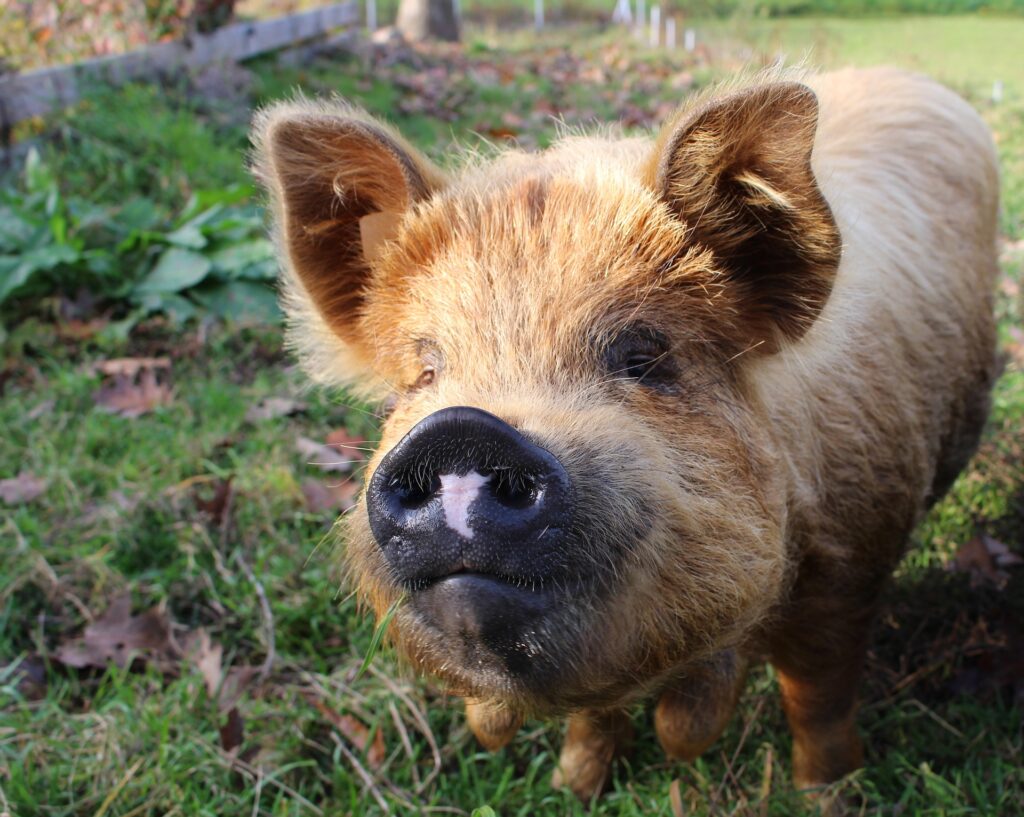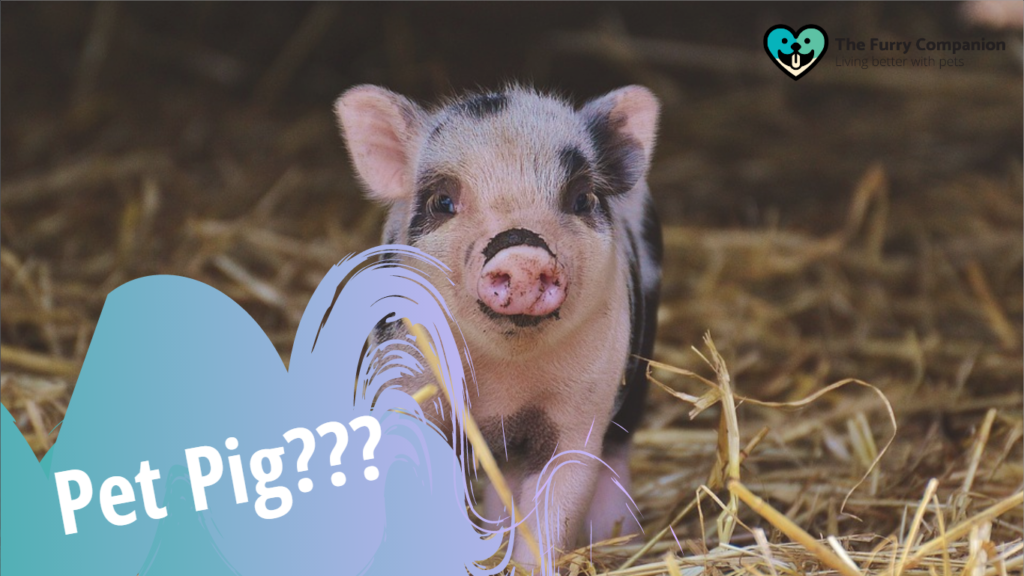Want pet pigs?
Source: Instagram
Portrayed as cute, intelligent, and talented, the adorable pet pig owns our hearts. Once in your life, you have probably thought of having pet pig as an adventure companion or a house pet.
We all know at least one pig icon in our childhood. Pigs are prominent in pop culture, and it is evident with famous pig characters in movies and cartoons. There’s Three Little Pigs in the famous nursery rhyme, Piglet in Winnie the Pooh, Looney Tunes’ Porky Pig, The Muppet Show’s Miss Piggy, Toy Story’s Hamm, Babe in Babe: Pig In The City, Peppa Pig, and many more.
So, if you’re interested to have a real-life companion pig, read The Furry Companion’s guide to keeping a pet pig.

Table of Contents
Traits of a Pet Pig
Pigs make great life companions. Over the years, interest in owning a pet pig has been growing at a steady pace. And why not? You can train them because they are highly intelligent and social. Plus, they are super cute!
We associate a lot of negative connotations with pigs, such as being dirty and greedy. In reality, they are the opposite. Pigs can be charming and delightful house pets.
You may think having a pet pig is like taking care of another common house pet, but many owners find pigs demanding. However, when given proper care and training, they can be an excellent match for you!
Intelligence
Pigs are one of the smartest animals on the planet, even more so than cats and dogs. They are quick learners, so you can teach them tricks and skills. They can also communicate and show emotions. Pig owners often say that they behave more like a 2- to 3-year-old toddler than a pet animal.
Like primates, they have complex social lives, which makes their intelligence remarkable.
They learn only from watching situations unfold. Among their own, they work to outsmart each other, especially when it comes to food. For example, one pig always grabs food from another pig. The outwitted pig would then learn to change its behaviors to adapt to this trickery.
They are also one of the best emotional support animals because they are highly compassionate. They can sense emotions and console you or give you comfort during grief.
Disposition
Pigs are highly social, playful, and gentle animals. They are naturally affectionate, so you can expect that they will enjoy your constant tummy rubs and snuggles.
As pack animals, they crave the closeness among other pack members. It means that they can get along well within a human family because they treat the members as a part of the pack. Take note, however, that they are also naturally prey animals, so they can easily be frightened.
Because of this, pigs are territorial. They can be cautious or even aggressive with strangers. It is crucial for you, as the owner, to establish that you are the “alpha” or the pack leader so that your pig won’t develop dominance aggression.
Also remember that they cannot be left home alone most of the time, especially during the day, as they tend to become destructive with their rooting behavior. Training them and taking them outside can help to tame this behavior.
Cleanliness
In our language, calling someone a pig connotes being dirty. But in truth, pigs are one of the cleanest animals. Usually, they do not excrete anywhere near their living or eating areas. Living in a filthy environment causes stress and irritates them.
Moreover, pigs don’t sweat despite having sweat glands. They have hypoallergenic hair, they do not shed, and they are odorless. However, this characteristic makes it hard for them to adjust to different temperatures.
Pet Pig Size
Pet pigs are classified according to their sizes. Do note, however, that the term “mini pig” includes many different sizes of pet pigs. In household pet standards, these “mini pigs” are still quite large.
The greatest misconception about the terms “teacup,” “miniature,” or “micro” pigs is that they are going to stay small forever. The fact is no healthy, growing pig breed will remain as tiny as they were at birth.
Some breeders use these terms carelessly, which results in misleading the expectations of pet owners. Some even cruelly starve the pigs and instruct pet owners to underfeed these “teacup” pigs to keep them small and dandy.

It is heartbreaking to see fully grown pigs being surrendered and neglected once owners realize that they could no longer take care of them. So before deciding to have a pet pig, make sure to do intensive research to know if you are ready to commit to this. You can also consult your local veterinarian to know which breed type best suits you.
Breeders and owners do not all agree with the naming of each size, but pet pigs generally fall under the following classifications:
- Miniature Pigs. Miniature pigs stand 16 to 26 inches tall and weigh between 100 and 200 pounds. They are smaller than farm pigs, which weigh around 800 pounds up.
- Teacup Pigs. The term “teacup” only refers to their size at birth, not in adulthood. They generally weigh around 35 to 45 pounds and are approximately 14 inches tall. They can hit 200 pounds as they grow.
- Micro mini pigs. Micro mini pigs weigh 18 to 30 pounds and may stand 10 to 13 inches tall at birth.
Popular Pet Pig Breed Types
Each pet pig breed has its unique traits and characteristics.
1. Pot-Bellied Pet Pig
Also known as the Vietnamese pot-bellied pig, this breed is the most popular type of mini pig. They are known for their friendly and affectionate behavior.
2. Juliana Pigs
Juliana pigs are a different breed from pot bellies. They are also known as the “miniature painted pig” as they have a colorful and spotted appearance. They have a long nose and are more similar in appearance to feral pigs.
3. Kune Kune Pigs

Kune Kune Pigs are hairy pig breeds with very short legs, round body, and two wattles on their chin. Their color ranges from white to black, gold, brown, or a white-and-black mixture.
They are independent but still make good indoor house pets, as well as backyard pets.
Taking Care of Your Pet Pig
The average life span of a pet pig ranges from 12 to 18 years. But in some cases, pigs live for more than 20 years.
If you are considering to have a pet pig, these are the things that you should take note of.

Housing
Pigs thrive in cool and low-stress environments. Thus, you need to keep them fresh and clean all the time. Make sure that they have a dry and warm place to sleep in. A tent or a sleeping box is common sleeping space for them. According to Bob Judd, DVM, DABVP, “Pigs are susceptible to sunburn, heat, and cold weather, so shade and bedding need to be provided.”
You can potty-train your pig so that the smell of their poop wouldn’t linger around the house. You can use a litter box. Alternatively, you can potty-train them in the backyard to give them a chance to move and exercise. Note, however, that they will not always abide by this routine, so expect a lot of cleaning and putting out the smell of pig poop around the house a lot.
Rooting is a natural behavior for pigs. They nudge into things repeatedly to be familiar with an environment or to find food. They also do this for comfort, communication, and cooling off.
Pigs can learn to love taking walks outside or even swimming!
When left outside, especially in soil, they tend to dig the ground to search for food. You can place a rooting box with treats or rocks around the house for them to unearth.
You would want to design your house as if a toddler is living with you. Pig-proof your home as you would baby-proof it for your children’s safety. Make sure the surroundings are safe, and they don’t have any access to areas such as electrical sockets and various tripping hazards.
Food
Pigs are healthy animals. They can be too fond of eating, so you will need to watch out for that. They are omnivores, and they need to have a balanced diet of vitamins, minerals, proteins, fibers, and carbohydrates. You can also give them a multivitamin, and they should always have access to water. Check out Amazon’s Choice Manna Mini-Pig Treats.
They should be fed at least two to three times a day with either pig feeds or non-starchy vegetables. As they naturally root, you can scatter treats such as fruits or vegetables around the house so they can search for it. Also, provide them space outside for rooting in the dirt as it is their source of minerals such as iron and selenium.
Although known to eat human food leftovers, this is not ideal because it doesn’t meet their proper nutritional needs. Never feed your pet pig cat or dog food. Its formula has too much protein, which is harmful to pigs.
Most importantly, it is prohibited to feed meat to your pig. Remember that pigs are omnivores; if they eat infected meat, the diseases will transfer to them. If not sure about what to feed them, the safest variety will be pig pellets that you can buy from pet or poultry supply stores.
Health Problems
Like us, pigs can be affected by several viruses and diseases, such as flu. Thus, they also require vaccinations. “Routine vaccination against various pathogens not only minimizes sickness but helps prevent zoonotic disease and may satisfy requirements for pet licensure,” D. Bruce Lawhorn , DVM, MS says. Make sure to have a reliable swine veterinarian in your contacts as regular pet clinics may not have enough expertise to treat your pet pig.
Also, make sure to consult a veterinarian about what to feed your pet pig so that it won’t grow to become obese or develop any growth problems. A fat roll over the pig’s eyes indicates that it is overweight. Overweight pigs can develop joint problems and pains such as arthritis.
As mentioned, make sure to provide a cool environment for your pigs to avoid overheating. Pigs need to cool off, so it is essential to give them regular baths. They may refuse it at first, but later on, when they get used to it, they will start to enjoy it. You can also place a portable airconditioning unit in your home where your pigs hang out the most. We recommend Compact FreeStanding Portable Air Conditioner which you can purchase here.
A common disease among pet pigs is mange, which is caused by mites. It results in dry, scaly, and itchy skin. When symptoms persist, make sure to seek treatment from a veterinarian.
Hoof Trimming
Pigs have two-toed hooves. A house pet pig may not wear and tear its hooves as farm pigs do. However, to prevent foot problems and avoid them from being overgrown, regular hoof trims by professional vets are needed. Check this hoof trimming file if you want to di it by yourself.
Neutering and Spaying
Pigs can mature sexually as early as three months of age. If this is not satisfied, they might start showing signs of aggressive behavior.
It is highly advised to neuter or castrate male pigs as early as possible, while they are still small and easy to handle. At this early stage, it will also heal more quickly. “The larger they become the harder the surgery is on them, and if you wait too long it might be too late to safely perform the surgery at all,” Jose Biascoechea, DVM, DABVP adds.
If you have both male and female pigs together and you do not have the male one neutered, you may end up with a dozen piglets in just about three months (the gestation period of pigs).
Also, spay female pigs to prevent the development of uterine problems. A licensed and experienced veterinarian does these procedures using pain medication.
Check These Things Before Owning a Pet Pig
- Legality. Check with your local government if owning a pet pig is legal in your area. Some cities and municipalities do not allow pigs within their boundaries.
- Pet Combinations. If you already have a pet dog at home, reconsider getting a pet pig. If you want to have both, you will always have to watch and supervise them. They don’t get along well because dogs are predators and pigs are preys, unlike the harmonious relationship between cats and pigs.
- Commitment. Pigs are affectionate and attached to their humans. Thus, they can become depressed when removed from their home.
The Verdict
Owning a pet pig is not for everyone. You need to have a strong commitment to taking care of them. You need to be meticulous about their environment, food, vet, and training.
As having a pet pig becomes popular, the animal also becomes a victim of this popularity. Some owners were poorly informed before they took home one, and as the pig grew, its needs overwhelmed them.
When a pet pig matures, most owners end up abandoning or giving them up to shelters or rescue centers. Unfortunately, these places do not always have enough capacity to take in pigs. So, most of them end up being euthanized or slaughtered.
Before deciding to get a pet pig, be sure that you will be with them until the end of their stay in this world.

Frequently Asked Questions
Are Pigs good house pets?
Pigs make good house pets. They are amazing household companions because they are sociable, intelligent, and trainable. Some pigs are fond of cuddling, giving kisses, and getting belly rubs. Its lifespan is 10 years, which is quite long and therefore getting one requires commitment.
What is the best pig for a pet?
The top breeds of pig for pets are Miniature Pig, Pot Bellied Pig, and Kune Kune Pig. Potbellied pigs are smaller in size than farm pigs. The miniature pigs are also known as teacup pigs and were initially for medical purposes. This kind of pig is best with a companion. Kune kune pig is originally from New Zealand and is the most ideal breed to play with the kids.
What is having a pet pig like?
A pet pig is like having a toddler in the household. While pigs are playful and intelligent much like a two-year-old they can also be stubborn and grumpy at times. Pigs require attention so it is best to train them.
How expensive is a pet pig?
A pet pig would cost around $700-$1,500, potbellied pigs specifically, costs $600-$800. Spaying or neutering would cost an additional expense of about $300-$500. Food can cost around $20 to $60 per month. Pet pigs would also need vaccinations and check-ups which costs $100-$300.
Do pigs bite?
Yes, pigs bite. When pigs are in distress or in fear, they tend to bite or lash out. Meanwhile, domesticated pigs are less likely to bite but still, it is important to train them.
Do pet pigs smell?
Pigs only smell because of their environment. Small pigs and pet pigs are less likely to smell since they are well-taken care of. Pigs are clean animals by nature.
Can you toilet train a pig?
Yes, pigs can be trained to go to the toilet. It is best to establish a routine for bringing them out or to the toilet. Reward your pet whenever they did a good job of going to the toilet for potty.
Are pigs dangerous pets?
Generally, domestic pigs are not dangerous. Although, as animals, they may have some tendencies to bite especially when provoked.
Are pet pigs smart?
Yes, pigs are definitely smart and they can be smarter than any other domestic animal as well. They have considerably high I.Q. to be able to solve problems and can be more trainable than cats or dogs. Although some studies found out how pigs can also have emotional capacities, pigs in general, are difficult to classify in terms of total intelligence.
Do pet pigs poop in the house?

